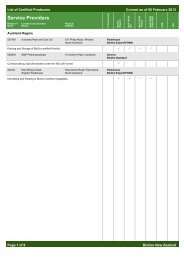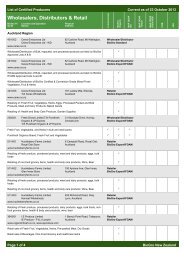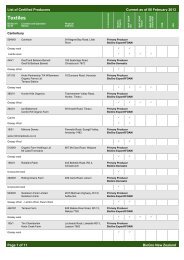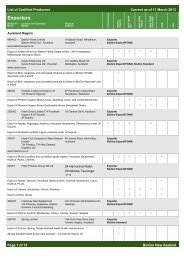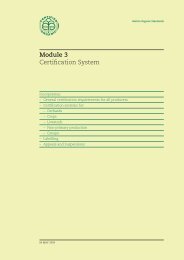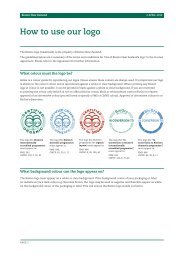Create successful ePaper yourself
Turn your PDF publications into a flip-book with our unique Google optimized e-Paper software.
<strong>BioGro</strong> New Zealand <strong>Technical</strong> <strong>Bulletin</strong> Issue 14 | November 2010In these cases contact Lucia (lucia@biogro.co.nz) or Nicolas (nicolas@biogro.co.nz) at the <strong>BioGro</strong> office and supply the specificationsheet and GMO declarations (if applicable). If the input is acceptable they will email or fax you written approval to use it for a specifiedperiod. There may be a charge to cover the work involved in assessing the input if it is a multi-ingredient product and involvesextensive research.If you use an input which doesn’t have current <strong>BioGro</strong> certification/written approval then a noncompliance or potentially a critical noncompliancewill be raised against your operation, and we need to report to NZFSA if you are on the export programme. We will thenendeavour to assess that input for compliance at the time of use. The outcome of this assessment may result in a market restriction foryour products and/or your certified land returning to registration for at least some markets. If we can’t obtain the complete formulationand production process for that input then it must be treated as a prohibited input and all affected land and products will losecertification. This is a very distressing situation and can be avoided by not using non certified/approved inputs.Treated posts and timber on properties certified to the USDA NOP and/or the Canada Organic Regime (COR)This notification updates our previous notification on treated posts and timber dated 26 June 2009, and the notifications on treatedposts and timber in <strong>Technical</strong> <strong>Bulletin</strong> Issue 12 November 2009 and <strong>Technical</strong> <strong>Bulletin</strong> Issue 13 May 2010.For properties certified to, or in conversion to, the USDA NOP, posts and timber treated with materials not listed as allowed in theUSDA NOP, including new and reused treated posts and timber already on the property, can not be used for new installations orreplacement purposes.For properties certified to, or in conversion to, the Canada Organic Regime, posts and timber treated with materials not listed asallowed in the COR can not be brought onto and used on the property, but treated posts and timber already on the property can bereused within the property.The above prohibitions must be applied to all properties certified to or in conversion to the NOP, and/or certified to or in conversion tothe COR, including dairy and livestock farms, orchards, vineyards, and cropping farms.For properties certified / in conversion to the NOP and/or the COR, existing in use treated posts and timber such as in existing fences,crop structures, livestock housing, and fruit bins on the property are acceptable, ie they do not need to be replaced with alternativematerials.Current OMPs for NOP certified / in conversion properties must address how the property is managed without the use of treated postsand timber, including without both new and recycled treated posts and timber, for new installations and replacement purposes as from1 July 2010.Current OMPs for COR certified / in conversion properties must address how the property is managed without bringing new andrecycled treated posts and timber onto the property for new installations and replacement purposes as from 1 July 2010.Properties certified / in conversion to the USDA NOP and/or the COR must be fully compliant with the above as from 1 July 2010.The NOP regulation requirements for this can be viewed at www.ams.usda.gov/nop then select Regulations then select ElectronicCode of Federal Regulations ( eCFR ) (Standards) website. Refer the following clauses:• NOP 205.105 (a) To be sold or labeled as “100 percent organic,” “organic,” or “made with organic (specified ingredients or foodgroup(s)),” the product must be produced and handled without the use of:(a) Synthetic substances and ingredients, except as provided in §205.601 or §205.603;(b) Nonsynthetic substances prohibited in §205.602 or §205.604;• 205.206 (f) The producer must not use lumber treated with arsenate or other prohibited materials for new installations orreplacement purposes in contact with soil or livestock.• NOP 205.601 which lists the allowed synthetic materials for primary production.• NOP 205.602 which lists the natural materials which are prohibited for primary production.The COR regulation requirements for this can be viewed at www.tpsgc-pwgsc.gc.ca/cgsb/on_the_net/organic/index-e.htmlthen select CAN/CGSB–32.310:Clause 5.2.2 The use of posts or wood treated with materials other than those in CAN/CGSB-32.311, Organic Production Systems— Permitted Substances Lists, is prohibited.a. Continued use and recycling of existing (prohibited) posts within the farm are allowed.b. Acquisition of any additional material with these wood treatments is prohibited for new installations or replacement purposes.Exceptions may be granted in vast rangeland and semi-arid regions, and will consider the availability of alternate materials.Also select CAN/GSB-32.311 for the Permitted Substances Lists.Also refer the Questions and Answers section of this <strong>Technical</strong> <strong>Bulletin</strong> for Q&As on this issue.4 of 14



